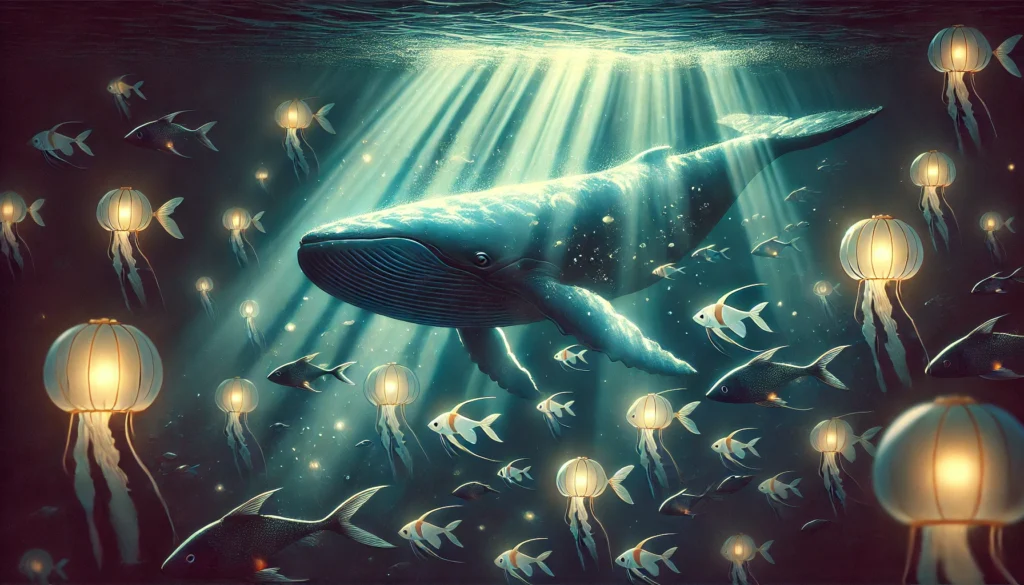Discover the magnificent marine mammals that inhabit Japan’s diverse waters and learn where to witness these majestic creatures in their natural habitat.
Introduction: The Cetacean Treasures of Japan
Japan’s relationship with whales and dolphins spans centuries, though today’s focus has shifted dramatically toward conservation and eco-tourism. The Japanese archipelago, with its unique position at the crossroads of major ocean currents and diverse marine ecosystems, offers some of the most spectacular cetacean viewing opportunities in Asia. From the icy waters surrounding Hokkaidō to the tropical seas of Okinawa, Japanese whales and dolphins represent a remarkable biodiversity treasure that attracts marine enthusiasts from around the world.
As we explored in our previous article on Japanese Maritime Geography, the country’s extensive coastline and varied marine environments create perfect habitats for numerous cetacean species. This comprehensive guide will take you through the best locations, optimal seasons, and ethical guidelines for observing Japanese whales and dolphins in their natural environment.
The Rich Diversity of Japanese Whales and Dolphins
Japan’s waters host an impressive variety of cetaceans, each adapted to specific marine environments across the archipelago. Understanding this diversity enhances any wildlife viewing experience.
Key Whale Species in Japanese Waters
Humpback Whales (Megaptera novaeangliae)
These magnificent creatures, known for their distinctive knobbly heads and impressive acrobatic displays, migrate through Japanese waters seasonally. Their complex songs and spectacular breaching behaviors make them favorites among whale watchers.
Sperm Whales (Physeter macrocephalus)
With their massive square-shaped heads and ability to dive deeper than any other mammal, sperm whales frequent certain regions of Japan, particularly during summer and autumn months. These giants represent the largest toothed predators on earth.
Bryde’s Whales (Balaenoptera brydei)
These tropical whales prefer warmer waters and are commonly spotted in southern Japan. Less known than their larger cousins, they nonetheless offer impressive sightings with their streamlined bodies and distinctive three ridges on their rostrum.
Baird’s Beaked Whales (Berardius bairdii)
These deep-diving specialists are occasionally spotted in northern Japanese waters, particularly around Hokkaidō. Their elusive nature makes every sighting particularly special for wildlife enthusiasts.
Common Dolphin Species
Bottlenose Dolphins (Tursiops aduncus)
Perhaps the most recognizable dolphin species, these intelligent and playful mammals form resident pods in several locations around the Japanese islands, offering some of the most interactive wildlife experiences available.
Risso’s Dolphins (Grampus griseus)
Distinguished by their scarred bodies and rounded heads, these unique dolphins inhabit deeper offshore waters around parts of Japan, particularly near Shikoku’s Pacific coast.
Dall’s Porpoises (Phocoenoides dalli)
With their distinctive black and white coloration, these fast-swimming porpoises are common in the northern waters of Japan, particularly around Hokkaidō where the cooler currents provide their preferred habitat.
The biodiversity of Japanese waters extends far beyond whales and dolphins, as we detailed in our guide to Japanese Biodiversity, but these marine mammals often create the most memorable wildlife encounters for visitors.
Regional Guide to Japanese Whales and Dolphins
Japan’s main islands each offer unique opportunities for whale and dolphin watching. Let’s explore each region’s distinctive cetacean populations and viewing opportunities.
Hokkaidō: Northern Species in Cold Waters
Japan’s northernmost main island hosts several cold-water cetacean species rarely seen elsewhere in the country:
- Dall’s porpoises sprint through these waters with remarkable speed, creating distinctive “rooster tails” of spray
- Orcas (killer whales) make seasonal appearances, hunting in coordinated pods
- Baird’s beaked whales occasionally surface between their deep-water hunting dives
Beyond cetaceans, Hokkaidō’s waters also host significant populations of harbor seals and Steller sea lions, making it a complete marine mammal destination. The best viewing season typically runs from late spring through summer when conditions are most favorable.
As explored in our article on The Currents of Japan, the meeting of warm and cold ocean currents around Hokkaidō creates nutrient-rich waters that support this diverse ecosystem.
Kantō Region: Island Cetacean Sanctuaries
The Kantō region offers some of Japan’s most accessible and reliable whale and dolphin watching opportunities, particularly around its offshore island groups:
Ogasawara Islands (Bonin Islands)
These remote UNESCO World Heritage islands provide world-class opportunities to observe:
- Humpback whales from February through April
- Sperm whales during summer and autumn months
- Resident bottlenose dolphins year-round
The islands maintain strict wildlife viewing protocols, including a 100-meter exclusion zone around humpbacks and a 50-meter zone around sperm whales, unless the animals themselves approach swimmers already in the water.
Izu Islands
This archipelago, particularly Miyake-jima and Mikura-jima, offers extraordinary opportunities to swim with wild dolphin pods:
- Bottlenose dolphins reside year-round around Mikura-jima, with approximately 200 individuals forming several pods
- Humpback whales migrate through these waters between December and March
- Sustainable tourism operators offer snorkeling experiences with the resident dolphin population
The Dolphin Communication Project on Miyake-jima studies these remarkable animals, contributing valuable research on their social structures and behaviors.
Chūbu Region: Coastal Encounters
While not as famous for cetaceans as other regions, the coastal waters of Chūbu, particularly around the Izu Peninsula and Mikomoto Island, regularly host dolphin pods. These areas provide opportunities for divers and boat-based observers to encounter dolphins in less crowded settings than some of the more popular watching locations.
Shikoku: Pacific Coast Migration Routes
The Pacific coastline of Shikoku, particularly in Kōchi Prefecture’s Kuroshio-chō area, lies along important cetacean migration routes:
- Humpback whales
- Sperm whales
- Bryde’s whales
- Risso’s dolphins
- Bottlenose dolphins
The prime watching season extends from April through September, with peak activity during July, August, and September. These waters represent one of Japan’s most reliable and diverse whale-watching regions.
Kyūshū: Southern Gateway
Kyūshū’s southern location provides access to both cold-water northern species and tropical southern species:
- The Amakusa islands in Kumamoto Prefecture host a remarkable population of approximately 1,200 Indo-Pacific bottlenose dolphins
- Amami Ōshima and the Tokara islands offer seasonal whale watching opportunities for migratory humpbacks, sperm whales, and Bryde’s whales
As detailed in our exploration of The Japanese Nansei Islands, this region represents a fascinating biogeographic transition zone where marine species from different climate zones overlap.
Okinawa: Tropical Whale Paradise
The subtropical waters of Okinawa Prefecture provide some of Japan’s premier whale-watching destinations:
Kerama Islands
These islands west of Okinawa’s main island are Japan’s most famous humpback whale watching destination between December and April. The clear blue waters and white sand backdrop create spectacular viewing conditions.
Yaeyama Islands
The southernmost island group in Japan offers opportunities to observe:
- Humpback whales
- Sperm whales
- Pilot whales
- False killer whales
These species are typically spotted during their northward migration in winter months.
Kume Island
Located approximately 100km west of Okinawa’s main island, Kume’s Tombara area offers winter sightings of humpback whales against stunning tropical backdrops.
Ethical Whale and Dolphin Watching in Japan
To ensure these magnificent marine mammals remain part of Japan’s natural heritage, responsible wildlife viewing practices are essential:
Guidelines for Responsible Observation
- Respect exclusion zones – Maintain the legally required distances (100m for humpbacks, 50m for sperm whales) unless the animals approach you
- Choose responsible operators – Select tour companies that follow wildlife protection guidelines and contribute to research efforts
- Never chase or harass cetaceans – Allow animals to approach or leave on their own terms
- Minimize noise pollution – Keep voices low and avoid sudden movements when near cetaceans
- Follow guide instructions – Professional guides understand animal behavior and safety requirements
The Future of Japanese Whales and Dolphins
The growing popularity of whale and dolphin watching in Japan represents a significant shift toward appreciation of living cetaceans. This economic alternative to historical whaling practices offers hope for continued conservation efforts throughout Japanese waters.
Just as we’ve witnessed dramatic changes in attitudes toward ocean preservation in recent years (as covered in our article on The Seas of Japan), the relationship between Japanese communities and cetaceans continues to evolve in positive directions.
Seasonal Guide to Observing Japanese Whales and Dolphins
Planning your visit according to cetacean migration patterns greatly increases your chances of successful wildlife encounters:
Winter (December-February)
- Humpback whales in Okinawa (Kerama Islands)
- Humpback whales in the Izu Islands
- Various dolphin species year-round in the Ogasawara Islands
Spring (March-May)
- Humpback whales in the Ogasawara Islands (until April)
- Beginning of whale season in Shikoku
- Resident dolphin populations in Mikura-jima
Summer (June-August)
- Sperm whales in the Ogasawara Islands
- Peak whale watching in Shikoku
- Baird’s beaked whales and other northern species in Hokkaidō
Autumn (September-November)
- Sperm whales in the Ogasawara Islands (early autumn)
- Last opportunities for whale watching in Shikoku
- Dolphin watching in the Amakusa islands of Kyūshū
Essential Tips for Whale and Dolphin Watching in Japan
To maximize your cetacean encounters while visiting Japan, consider these practical recommendations:
When to Book
Reserve popular whale watching tours well in advance, especially for peak season viewings in destinations like the Kerama Islands (winter) and Ogasawara Islands (spring).
What to Bring
- Waterproof camera or underwater housing
- Polarized sunglasses to reduce water glare
- Motion sickness medication if prone to seasickness
- Light, quick-drying clothing and sun protection
- Binoculars for boat-based observation
Language Considerations
While many tour operators in popular areas offer English guidance, learning a few key Japanese phrases can enhance your experience:
- クジラ (kujira) – whale
- イルカ (iruka) – dolphin
- 見えた! (mieta!) – I saw it!
- すごい! (sugoi!) – Amazing!
Transportation Access
As mentioned in our article on The Main Islands of Japan, travel between islands often requires careful planning. Remote cetacean hotspots like the Ogasawara Islands involve overnight ferry journeys, while others like the Kerama Islands can be reached by day trips from major centers.
Beyond Observation: Deeper Connections with Japanese Whales and Dolphins
For those seeking more meaningful engagement with Japanese marine life:
Research and Conservation Efforts
Several organizations welcome volunteer participants in their research efforts, including:
- The Mikura-jima Dolphin Research Project
- Ogasawara Whale Watching Association
- Okinawa Cetacean Research Group
Educational Resources
Marine research centers in locations like Chichi-jima (Ogasawara) and Zamami (Kerama Islands) offer displays about local cetacean populations, their behaviors, and conservation challenges.
Cultural Connections
Much like the traditions of the Ama divers we explored in The Ancient Tradition of Ama Divers, coastal communities throughout Japan have developed unique relationships with marine mammals over centuries. Local museums in whaling towns like Taiji preserve these historical connections while many communities now embrace conservation-focused approaches.
Conclusion: The Profound Experience of Japanese Whales and Dolphins
Encountering Japanese whales and dolphins in their natural habitat offers more than spectacular wildlife viewing—it provides a profound connection to the ocean and its magnificent inhabitants. As Japan continues to develop sustainable ecotourism around its remarkable cetacean populations, visitors gain unparalleled opportunities to witness these intelligent marine mammals.
From the tropical waters of Okinawa to the cold currents of Hokkaidō, Japanese whales and dolphins represent living treasures that deserve our admiration, respect, and protection. By choosing ethical wildlife experiences and supporting conservation efforts, visitors contribute to ensuring these magnificent creatures remain part of Japan’s natural heritage for generations to come.
Whether you’re swimming alongside playful dolphins in Mikura-jima or watching humpbacks breach in the Kerama Islands, encounters with Japanese whales and dolphins create memories that last a lifetime—and a deeper appreciation for the remarkable biodiversity of Japan’s marine environments.
Have you had memorable encounters with Japanese whales and dolphins? Share your experiences in the comments below!
Ready to plan your Japanese cetacean adventure? Check out our related guides:





